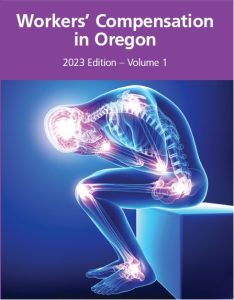 The 2023 edition of Workers’ Compensation in Oregon is due out in June. It includes a new chapter on combined conditions. This useful, 22-page chapter was written by Daniel Walker with SAIF Corporation in Salem.
The 2023 edition of Workers’ Compensation in Oregon is due out in June. It includes a new chapter on combined conditions. This useful, 22-page chapter was written by Daniel Walker with SAIF Corporation in Salem.
This post is an excerpt from the introduction to that chapter. The full chapter can be accessed via the full print book available for pre-order here, purchased as a stand-alone eBook here, or viewed on the BarBooks™ online library.
§ 12.1 SCOPE OF CHAPTER
This chapter provides an overview of combined-condition law. Combined conditions implicate both injury and occupational disease claims and are frequently at issue in workers’ compensation case workup and compensability considerations. Other chapters dealing with specific claims may provide a more detailed analysis regarding the application of a combined condition in a specific scenario.
§ 12.2 BACKGROUND AND OVERVIEW
Oregon adopted a special status for “combined conditions” when the legislature altered the definition of a compensable injury as part of an overhaul of Oregon’s workers’ compensation laws during a 1990 special legislative session. Or Laws 1990, ch 2, § 3 (Spec Sess). The legislature added a subparagraph specifying that when “a compensable injury combines with a preexisting disease or condition to cause or prolong disability or a need for treatment,” the combined condition “is compensable only to the extent the compensable injury is and remains the major contributing cause of the disability or need for treatment.” ORS 656.005(7)(a)(B) (1990).
Following that 1990 special session, however, the Oregon Court of Appeals concluded that the legislature had failed to create a process for denying combined conditions. See Brown v. SAIF Corp., 361 Or 241, 279, 391 P3d 773 (2017). The legislature addressed that oversight, and more, by adding numerous requirements for accepting and denying specific conditions, including combined conditions.
In 1995, the legislature enacted a major revision to the workers’ compensation statutes, in large part in response to a number of court decisions that had interpreted the 1990 legislation. Or Laws 1995, ch 332. SB 369 (1995) was intended to address a number of those prior appellate court decisions. One of them was United Airlines, Inc. v. Brown, 127 Or App 253, 257, 873 P2d 326, rev den, 319 Or 572 (1994), which held that “[n]othing in the text or context of ORS 656.005(7)(a)(B) suggests that the legislature intended that provision to provide an employer with the procedural authority to deny an accepted claim.”
To address the “loophole” identified by United Airlines, the legislature enacted provisions that are now codified at ORS 656.262(6)(c) and ORS 656.268(1)(b), which expressly provide a process for an employer to deny a combined-condition claim when the “accepted” injury is no longer the major cause of the combined condition. Or Laws 1995, ch 332, §§ 28, 30; see also SAIF Corp. v. Belden, 155 Or App 568, 572–74, 964 P2d 300 (1998), rev den, 328 Or 330 (1999) (“Now, an insurer can accept a combined condition pursuant to ORS 656.005(7)(a)(B) without being concerned that it will be obliged to continue to pay compensation for that condition if it stops being compensable.”).
In 2001, the legislature clarified the burden of proof for combined-condition injury claims. Or Laws 2001, ch 865, § 2. SB 485 (2001) amended ORS 656.266 to provide that in combined-condition claims once the worker has established that an injury is compensable, the employer has the burden of proof to show that the “otherwise compensable injury is not, or is no longer, the major contributing cause” of the disability or the need for treatment.
§ 12.3 DEFINITION OF COMBINED CONDITIONS
Combined conditions arise under ORS 656.005(7)(a)(B), which provides as follows:
If an otherwise compensable injury combines at any time with a preexisting condition to cause or prolong disability or a need for treatment, the combined condition is compensable only if, so long as and to the extent that the otherwise compensable injury is the major contributing cause of the disability of the combined condition or the major contributing cause of the need for treatment of the combined condition.
A combined condition is one in which two conditions merge or exist harmoniously. Luckhurst v. Bank of America, 167 Or App 11, 16–17, 1 P3d 1031 (2000); Gary E. Lombardo, 53 Van Natta 1634 (2001). A combined condition “may constitute either an integration of two conditions or the close relationship of those conditions, without integration.” Multifoods Specialty Distribution v. McAtee, 164 Or App 654, 662, 993 P2d 174 (1999), aff’d, 333 Or 629, 43 P3d 1101 (2002). However, a preexisting condition and its symptoms do not constitute two separate conditions that can combine. Carrillo v. SAIF Corp., 310 Or App 8, 11–12, 484 P3d 398, rev den, 368 Or 560 (2021).